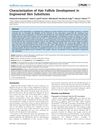TLDR Loss of sebaceous glands and inflammation may contribute to the development of scarring alopecia.
In 2011, a study investigated the involvement of sebaceous gland loss and inflammation in the development of primary scarring alopecia (SA). The researchers reviewed 90 specimens and found that sebaceous gland loss was significantly more prevalent in SA cases, with over 53% of follicles affected on average, compared to less than 5% in non-SA cases. Sebaceous gland duct inflammation was also more common in SA, suggesting it may contribute to follicular damage in SA. The study highlighted that sebaceous gland dysfunction is a frequent early feature in SA, particularly in conditions like lichen planopilaris, follicular degeneration syndrome, and others, with 100% occurrence in some types. The findings suggest that inflammation and dysfunction of the sebaceous gland ducts might play a role in the transition from non-scarring to scarring alopecia in certain cases. However, the conclusions are limited by the small sample size for some alopecia types and the subjective nature of inflammation grading. Further research, especially using animal models, is needed to understand the sebaceous glands' role in SA more clearly.
503 citations
,
May 2009 in “Cell stem cell” Lrig1 marks a unique group of stem cells in mouse skin that can become different skin cell types.
74 citations
,
July 2008 in “Dermatologic therapy” Early detection and histopathology are crucial to prevent permanent hair loss in cicatricial alopecia.
35 citations
,
July 2008 in “Dermatologic therapy” Cicatricial alopecia may be caused by immune attacks on hair follicles, gland issues, or stem cell damage.
 34 citations
,
June 2008 in “In vitro cellular & developmental biology. Animal”
34 citations
,
June 2008 in “In vitro cellular & developmental biology. Animal” Scientists created a long-lasting stem cell line from human hair that can turn into different skin and hair cell types.
949 citations
,
January 2001 in “Cell” Adult mouse skin contains stem cells that can create new hair, skin, and oil glands.
179 citations
,
June 2000 in “The American journal of pathology” The absence of functional sebaceous glands causes hair follicle destruction and scarring alopecia.
57 citations
,
August 1999 in “Archives of dermatology” Hair follicles grow hair and release it through the skin.
 April 2021 in “Journal of Investigative Dermatology”
April 2021 in “Journal of Investigative Dermatology” Cyclooxygenase-2 overexpression in mice skin causes hair loss like human androgenetic alopecia.
 30 citations
,
April 2018 in “Experimental Dermatology”
30 citations
,
April 2018 in “Experimental Dermatology” The article concludes that developing in vitro models for human hair structures is important for research and reducing animal testing, but there are challenges like obtaining suitable samples and the models' limitations.
 14 citations
,
July 2015 in “Journal of Cosmetic Dermatology”
14 citations
,
July 2015 in “Journal of Cosmetic Dermatology” Sebaceous glands in male pattern hair loss patients have more lobules and might cause early hair growth phase shifts.
 41 citations
,
June 2013 in “PLOS ONE”
41 citations
,
June 2013 in “PLOS ONE” Engineered skin substitutes can grow hair but have limitations like missing sebaceous glands and hair not breaking through the skin naturally.
 37 citations
,
June 2011 in “Journal of The American Academy of Dermatology”
37 citations
,
June 2011 in “Journal of The American Academy of Dermatology” Loss of sebaceous glands and inflammation may contribute to the development of scarring alopecia.
Alopecia areata is an autoimmune disease that targets hair follicles.
 November 1993 in “PubMed”
November 1993 in “PubMed” High levels of androgens can cause skin issues like acne, hair loss, and excessive hair growth.








